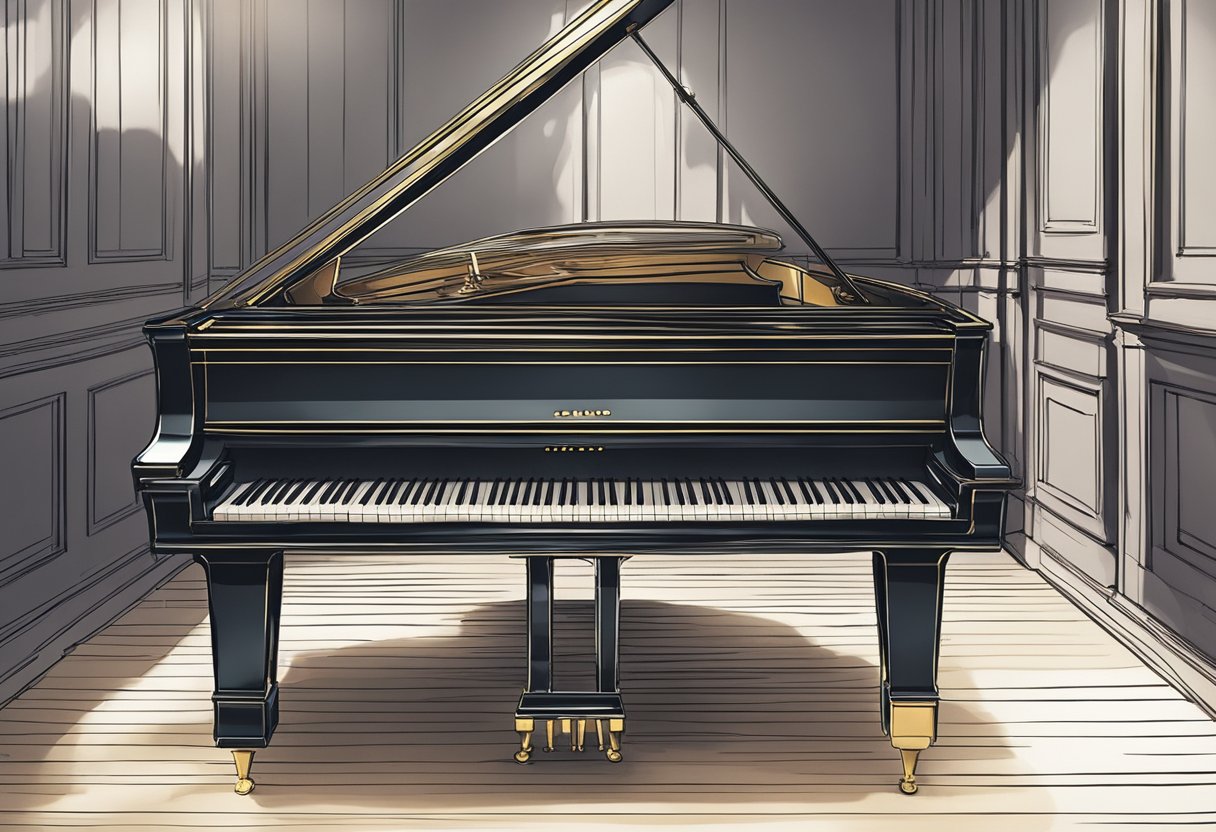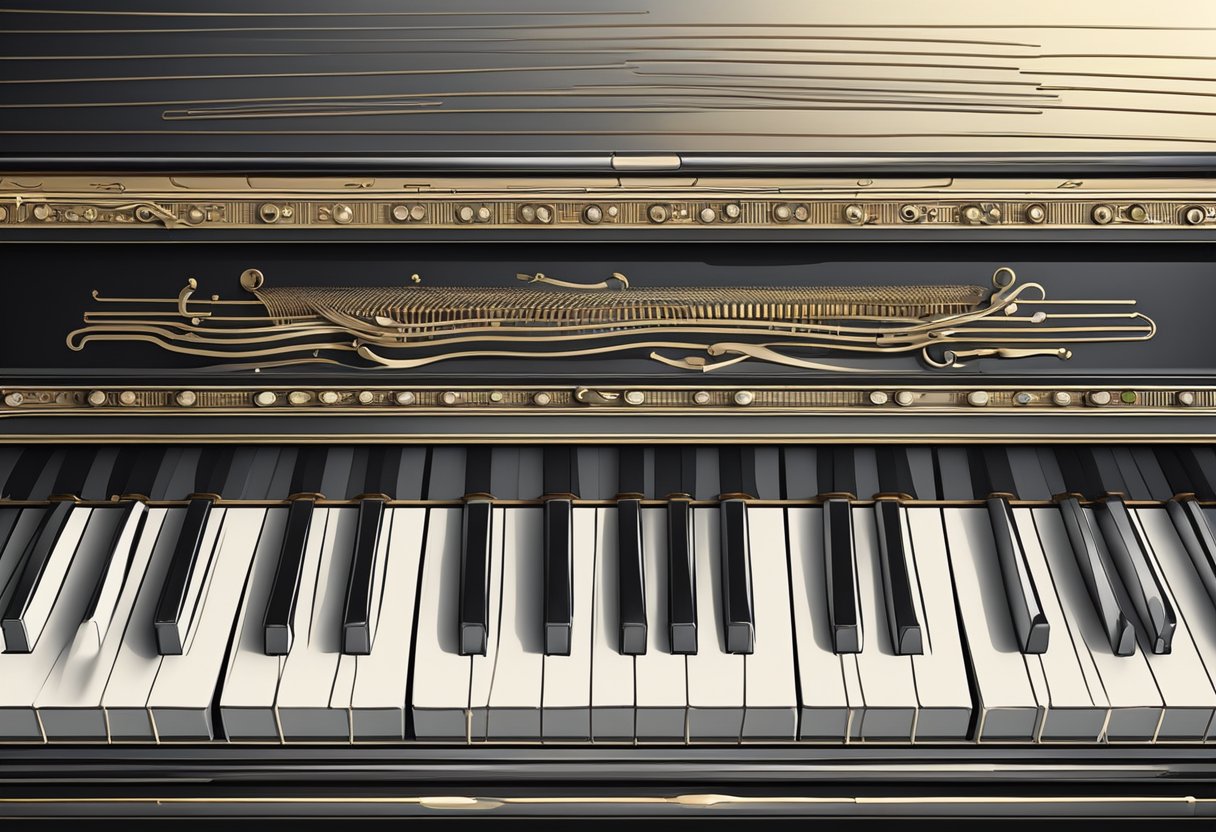As an Amazon Associate I earn from qualifying purchases.
Pianos go out of tune primarily due to the natural stretch of the strings and fluctuations in humidity and temperature. As you might recall from your last practice session or recital, an acoustic piano’s pitch can be affected even by frequent playing or the gentle shift of seasons.
Take, for example, a finely crafted grand piano in a concert hall; despite its impeccable construction, it requires regular tuning to perform at its best, highlighting the simple truth that all pianos, regardless of age or quality, drift from their precise tuning over time.
Want to Learn Piano?Click Here

Engaging with your piano tuner might reveal some interesting insights about your instrument’s unique tendencies. In my teaching studio, I’ve observed that the new acoustic piano we acquired needed more frequent tunings in its first year, just as the strings and soundboard were settling in.
This is a common occurrence that many pianists witness with their instruments.
Maintaining a consistent environment for your piano can help preserve its tuning. From my experiences performing in various venues, I can vouch for the effects of a stable versus a variable climate. Instruments kept in a room with controlled temperature and humidity are less likely to experience the drastic out-of-tune episodes that can happen when these factors are not managed.
Whether you’re a beginner fascinated by the mechanics of your piano, or an enthusiast trying to ensure the longevity of your beloved instrument, understanding these nuances can significantly enrich your musical journey.
Fundamentals of Piano Tuning

Piano tuning is an essential skill for maintaining the quality and longevity of acoustic pianos. Proper tuning ensures that each note produced matches the exact pitch it is intended to have.
Defining Tuning
Tuning is the process of adjusting the tension of a piano’s strings to achieve the correct pitch for each note. The goal is for your piano to conform to a specific tuning standard, typically the equal temperament, where the octave is divided into twelve equal semitones.
This makes it compatible with other instruments and harmonious across various keys.
Piano Tuning Tools
A piano tuner, or a professional piano technician, uses a variety of tools to tune a piano accurately. The most important tool is the tuning lever, also called a tuning hammer, which is used to turn the tuning pins and adjust string tension. Other essential tools include:
- Mutes: to isolate individual strings.
- Electronic Tuning Devices (ETD): for measuring pitch,
- Felt Temperament Strip: to mute adjacent strings during tuning.
Role of a Piano Technician
A piano technician is not only skilled in tuning but also in the overall maintenance and repair of pianos. Their expertise extends beyond just adjusting pitch; they need to assess the piano’s condition, including the tightness of pins, the resilience of the hammers, and the stability of the strings.
Regular visits from a professional piano technician can prolong the life of your piano and keep it sounding its best. They’ll notice issues that may not be obvious to average players, ensuring that the piano’s voice remains clear and true.
Why Pianos Go Out of Tune
When you sit down at a piano, the harmony and melody that flow from your fingertips are the result of precise tuning. But pianos are sensitive instruments, and several factors can lead to them falling out of tune.
Influence of Humidity and Temperature
Humidity and temperature greatly affect your piano’s tuning stability. Fluctuations in these environmental conditions cause the piano’s wooden soundboard to expand and contract.
This, in turn, changes the tension on the strings, leading to a piano that sounds out of tune. Seasonal changes bring seasonal humidity changes, so tuning adjustments may be necessary with every new season.
Impact of Playing and Usage
Regular playing and use apply stress on piano strings and the mechanical parts involved in producing sound. Over time, the tension from the hammers striking each string causes cumulative effects, necessitating retuning. The more you play, the more the string tension is affected, leading to natural detuning.
String Tension and Tuning Pin Mechanics
Piano strings are held in place by tuning pins, which are adjusted for pitch control. However, string tension can cause these pins to slip over time, resulting in a loss of proper tension and an out of tune sound. Proper technique in tuning and ensuring the pins are set snugly can reduce this slipping, but it’s an ongoing battle against physics.
Aging of the Piano
Just as with many things, pianos age. As they grow older, parts wear out and materials degrade. This natural process impacts the tuning stability.
Aged felts, for instance, may compress unevenly, and the humidity change or temperature change will impact an older piano more drastically than a newer one. So, it’s important to understand that your piano’s age can require more frequent tunings to stay in harmony.
Material and Design Factors
When you look at a piano, you’re not just seeing an instrument; you’re seeing a complex amalgamation of materials and design elements that must work in harmony. These elements are crucial to maintaining the piano’s tune over time.
Wood and Soundboard Behavior
The soundboard, typically made of spruce, is the heart of your piano’s voice. It has a naturally resonant quality that amplifies sound. But wood is susceptible to the environment: it can expand and contract with changes in humidity and temperature.
A flat crown in the soundboard—a sign of it not curving upward properly—can reduce its ability to transfer vibrations effectively, leading to tuning instability.
Construction and Expansion
Every part of the piano that’s crafted from wood, including the frame or case, can be affected by this expansion and contraction. Hardwoods, used in the construction of the piano’s framework, help to maintain its overall stability.
However, when these woods expand or contract significantly, it can cause a slight shift in the cast iron plate, also known as the piano’s plate, which can alter the tension of the strings and result in tuning issues.
Bridge and Pinblock Functions
Your piano’s bridges and pinblock play key roles in tuning stability. The bridges transfer the string vibrations to the soundboard, and if they shift due to material changes, the tone can suffer.
The pinblock, a dense block of wood beneath the metal tuning pins, holds these pins tightly so they don’t slip. If the pinblock loses its grip, possibly from the woodwearing down or losing density over time, the pins may turn more easily and the strings can detune.
Understanding these aspects of your piano’s anatomy can unveil why consistent tuning and maintenance is paramount to that ideal sound you love. Remember, pianos are like living entities, with wooden “bones” and a metallic “nervous system” that react and adjust to their surroundings.
As you play and care for your instrument, you’ll become more attuned to its unique characteristics and needs.
Maintaining Piano Tuning
Maintaining the tuning of your piano is a delicate balance of regular care, environmental monitoring, and understanding the intricacies of your instrument. You want your piano to sound its best and preserve its tonal integrity.
Regular Tuning Schedule
To ensure your piano remains in tune, it’s essential to establish a regular tuning schedule. The string tension across the piano’s harp must be adjusted periodically because it gradually changes due to regular play and fluctuation in temperature and humidity.
It is recommended to tune your piano at least twice a year, although some pianists prefer more frequent tunings to keep their instrument sounding perfect. Regular tunings not only maintain pitch but also prevent larger shifts in string tension that can make comprehensive tunings more challenging over time.
Environmental Control
The environment around your piano can greatly affect its tuning stability; you’ll need to manage factors such as dampness, moisture, and especially relative humidity.
Significant humidity changes can cause the wooden parts of the piano, which support string tension, to swell or shrink, leading to detuning. Using a humidifier or dehumidifier to keep relative humidity near 42% can help keep your piano more stable throughout the seasons.
Long-term Piano Care
In addition to regular tunings and humidity control, long-term piano care is key to maintaining tuning stability. This involves occasionally adjusting the tension of all strings (a full tuning), inspecting the soundboard, bridges, and pinblock, and refurbishing parts as necessary.
Also, consider where you place your piano; it should be away from windows, doors, and heating or cooling vents to prevent direct exposure to the elements.
Advanced Considerations
When tuning a piano, certain sophisticated techniques and factors can critically affect the outcome. These include how a pitch raise is executed, understanding the role of string elasticity in tuning stability, and how voicing and regulation may impact the consistency of your piano’s sound.
Pitch Raise Technique
Before diving into a standard tuning, your piano may require a pitch raise if it’s significantly out of tune. This is more than a mere adjustment; it’s a careful process where the tension of all the strings is systematically increased to the correct level.
Bear in mind, repeated pitch raises can affect a piano’s tuning stability due to the increased elasticity of the strings. From my experience, this should be done incrementally to ensure that the strings stabilize properly.
Tuning Stability and String Elasticity
Tuning Stability is significantly influenced by the elasticity of piano strings. Over time, strings stretch and contract, which is why a newly tuned piano may drift out of tune later as the strings settle. It’s akin to how new guitar strings need a break-in period before they hold pitches well.
Regular tunings maintain the consistency of string tension, which contributes to a more stable tuning over time.
Voicing and Regulation Influence
Lastly, voicing and regulation may not seem directly related to tuning, but they can alter your perception of the piano’s tone. Voicing adjusts the piano’s timbre by changing the hardness of the hammer felts. This can affect the dynamic response of a note.
Similarly, regulation, which is the adjustment of the mechanical action, ensures that all parts work in harmony. If the action is unregulated, even a well-tuned piano can sound uneven and lack consistency. Regular attention to these areas complements tuning and can ensure your piano not only sounds in tune but also has the desired tonal quality and responsiveness.
Hello & thanks for stopping by! I’m a professional concert pianist and piano instructor. In the United States, I’ve given successful performances in several places including New York, Florida, Connecticut, & New Jersey, I have also performed internationally in Italy and made my Carnegie Hall debut in 2014. I enjoy blogging about the piano, the art of performance, general music, current events and the latest in music production.
